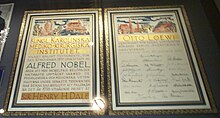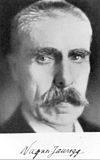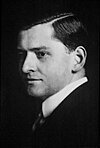List of Austrian Nobel Prize Winners

Nobel Prize diploma from Otto Loewi
The list of Austrian Nobel Prize winners includes all previous Nobel Prize winners who were born in Austria or who did the part of their work for which they were awarded the Nobel Prize with Austrian citizenship . This partly also includes people who were born in the national territory of the states whose legal successor is now the Republic of Austria. This essentially applies to the Austro-Hungarian monarchy and the Austrian Empire .
To date, according to this definition, 22 people designated as Austrians have received a Nobel Prize in one of the six categories. It should be noted in this regard that some of the persons listed here were no longer Austrian citizens or had dual citizenship at the time they were awarded the Nobel Prize .
Austrian Nobel Prize Winner
| Surname | place of birth | Nobel Prize category | Award year | image |
|---|---|---|---|---|
| Bertha von Suttner | Prague | Nobel Peace Prize | 1905 | |
| Bertha von Suttner (1843–1914) is an important companion of the Nobel Prize. She was Alfred Nobel's private secretary for a short time and later kept in touch with him in writing, apparently encouraging him to donate the prize. It was not until 1905, when she was awarded the fifth award, that she herself received the award for her life's work. |

|
|||
| Alfred Hermann Fried | Vienna | Nobel Peace Prize | 1911 | |
| Alfred Hermann Fried (1864–1921) became a staunch pacifist in 1881 after visiting a war painting exhibition . Ten years later he began to devote himself intensively to peace propaganda. From 1892 he and Bertha von Suttner published the magazine Die Waffen! for the publication of which he was awarded the Nobel Peace Prize in 1911 together with other pacifist activities. |

|
|||
| Robert Bárány | Vienna | Nobel Prize in Physiology or Medicine | 1914 | |
| The ear doctor Robert Bárány (1876–1936) received the Nobel Prize in Physiology or Medicine in 1914 for his study of the physiology of the human vestibular apparatus (semicircular canal apparatus in the ear ). With his work he created the basis for labyrinth surgery, through which the risk of meningitis due to inner ear suppuration could be averted. |

|
|||
| Fritz Pregl | Laibach | Nobel Prize in Chemistry | 1923 | |
| Fritz Pregl (1869–1930) was an important pioneer in the further development of clinical-chemical analysis. His most important work today is the refinement and specification of the elemental analysis according to Liebig. In 1923 he was honored with the Nobel Prize in Chemistry for the microanalysis of organic substances he developed. |

|
|||
| Richard Zsigmondy | Vienna | Nobel Prize in Chemistry | 1925 | |
| Richard Adolf Zsigmondy (1865–1929) was an important researcher in the field of colloid chemistry and microscopy . As a result of his scientific work, he was awarded the Nobel Prize for Chemistry in 1925, which was awarded to him in 1926 for “the elucidation of the heterogeneous nature of colloidal solutions and for the methods used for them, which are fundamental to modern colloid chemistry”. |

|
|||
| Julius Wagner-Jauregg | catfish | Nobel Prize in Physiology or Medicine | 1927 | |
| Julius Wagner-Jauregg (1857–1940) was originally a doctor of internal medicine before he began his career as a psychiatrist in 1885 at the Lower Austrian mental institution. He received the Nobel Prize in Physiology or Medicine in 1927 for his discovery of the therapeutic effects of malaria vaccinations for progressive paralysis (progressive paralysis). Due to the antibiotic developed shortly afterwards, however , his research was of only historical value from the 1940s onwards. |

|
|||
| Karl Landsteiner | Baden near Vienna | Nobel Prize in Physiology or Medicine | 1930 | |
| Karl Landsteiner (1868–1943) is known today as the discoverer of blood groups and the rhesus factor . For the former achievement he was awarded the 1930 Nobel Prize in Physiology and Medicine. Landsteiner is considered one of the greatest Austrian doctors, which is also reflected in the fact that his portrait was on the front of the 1000 Schilling note until the euro changeover . |

|
|||
| Erwin Schrödinger | Vienna | Nobel Price for physics | 1933 | |
| Erwin Schrödinger (1881–1961) is considered one of the fathers of quantum physics . Schrödinger succeeded Max Planck at the Friedrich Wilhelms University in Berlin as early as 1927 . In the year the Nobel Prize was awarded to Schrödinger, Schrödinger emigrated to Great Britain because the National Socialists had come to power. Finally, in 1933, he was the first Austrian to receive the Nobel Prize in Physics for his work in the field of quantum physics (and in particular for setting up the Schrödinger equation named after him ). Schrödinger's face was initially shown on the old 1000 Schilling note before Landsteiner replaced him in this function. |

|
|||
| Victor Franz Hess | Deutschfeistritz | Nobel Price for physics | 1936 | |
| Victor Franz Hess (1883–1964) worked as a researcher mainly on radioactivity and other forms of radiation. In 1936 he was honored with the Nobel Prize in Physics for his discovery of cosmic rays . Due to his open rejection of the National Socialist regime, Hess was dismissed from his research work at the Karl-Franzens-University in Graz in 1938 without notice and without any pension entitlement. In addition, he was forced to exchange the prize money for the Nobel Prize for German Reich treasure bills. That is why Hess emigrated to the USA in the same year. |

|
|||
| Otto Loewi | Frankfurt am Main | Nobel Prize in Physiology or Medicine | 1936 | |
| Otto Loewi (1873–1961) was an originally German pharmacologist who was particularly concerned with the function and structure of nerves and synapses . In 1921, with dual Austrian / German citizenship at the University of Graz, he was able to prove the chemical conduction of nerve impulses for the first time . For this discovery and its evidence, he and his American research colleague Henry Hallett Dale received the 1936 Nobel Prize in Medicine. After the National Socialists came to power and Austria was annexed to the German Empire, Loewi was forced to leave the country due to his Jewish descent. In 1938 he emigrated first to Belgium, then to Great Britain and finally to the United States. |

|
|||
| Richard Johann Kuhn | Vienna | Nobel Prize in Chemistry | 1938 | |
| Richard Johann Kuhn (1900–1967) was a biochemist who worked in Austria during the Nazi era . Kuhn received the Nobel Prize in Chemistry in 1938 for his work on carotenoids and vitamins , but was only able to accept it in 1948 due to a decree by the German government. From today's perspective, Richard Kuhn is extremely controversial because of his attitude towards National Socialism and his help in the development of neurotoxins such as soman . |

|
|||
| Wolfgang Pauli | Vienna | Nobel Price for physics | 1945 | |
| Wolfgang Pauli (1900–1958) was already considered a mathematical prodigy in his youth. After studying physics in the shortest possible time and earning his doctorate summa cum laude in 1921, he quickly gained a reputation as an outstanding physicist in quantum mechanics . Finally, in 1945, Pauli received the Nobel Prize in Physics for formulating what is now known as the Pauli Principle , the exclusion principle of quantum mechanics. |

|
|||
| Carl Ferdinand Cori | Prague | Nobel Prize in Physiology or Medicine | 1947 | |
| Carl Ferdinand Cori (1896–1984) studied at the Karl Ferdinand University in Prague and received his doctorate there in 1920. While still at university he met his future wife Gerty Cori , with whom he subsequently researched. After completing his studies in Prague, Cori worked as an assistant to the later Nobel Prize winner Otto Loewi at the Universities of Vienna and Graz. In 1922, the Coris emigrated together to the United States, where they worked in St. Louis and Boston. In 1947, Carl Ferdinand Cori, his wife Gerty Cori and the Argentine physiologist Bernardo Alberto Houssay jointly received the Nobel Prize in Physiology or Medicine for their discovery of the course of the catalytic glycogen metabolism, which was later known as the Cori cycle . |

|
|||
| Max Ferdinand Perutz | Vienna | Nobel Prize in Chemistry | 1962 | |
| Max Ferdinand Perutz (1914–2002) was an Austrian chemist who also fled to Great Britain in 1936 before the threat of the Nazis coming to power. In 1947 he founded the Department of Molecular Biology as a professor at Cambridge University , which he headed until 1949. Together with his colleague, Sir John Cowdery Kendrew , Perutz received the Nobel Prize in Chemistry in 1962 for their X-ray structural studies of proteins. |

|
|||
| Konrad Lorenz | Vienna | Nobel Prize in Physiology or Medicine | 1973 | |
| Konrad Lorenz (1903–1989) is considered the founding father of classic comparative behavioral research ( ethology ) in the German-speaking world . The doctor of medicine, who received his doctorate from the University of Vienna, has been intensively concerned with animal behavior since completing his studies and received his habilitation in 1936 for a license to teach "zoology with special consideration of comparative anatomy and animal psychology". In 1973, together with Karl von Frisch and the Dutchman Nikolaas Tinbergen, he received the Nobel Prize in Physiology or Medicine for discoveries about the organization and triggering of individual and social behavioral patterns. |

|
|||
| Karl von Frisch | Vienna | Nobel Prize in Physiology or Medicine | 1973 | |
| Karl von Frisch (1886–1982) was just like Konrad Lorenz an important behavioral scientist and zoologist . The focus of his research work, which he carried out as part of a long-term professorship at the University of Munich, was the exploration of the sensory perception of honey bees and their mutual communication. In 1973, together with Konrad Lorenz and Nikolaas Tinbergen , he was awarded the Nobel Prize in Physiology or Medicine for their discoveries about the organization and triggering of individual and social behavioral patterns. | ||||
| Friedrich August von Hayek | Vienna | Nobel Prize in Economics | 1974 | |
| Friedrich August von Hayek (1899–1992) was one of the most important representatives of the Austrian School of Economics , a neoliberal branch of economics. Hayek, who is regarded as one of the most important masterminds of neoliberalism, was named in 1974 together with the Swede Gunnar Myrdal for their pioneering work in the field of monetary and business cycle theory and their analysis of the connection between economic, social and institutional phenomena with the “Alfred Nobel Memorial Prize for Economics ”, commonly known as the Nobel Prize for Economics . To this day he is the only Austrian who has ever received this award. |

|
|||
| Walter Kohn | Vienna | Nobel Prize in Chemistry | 1998 | |
| Walter Kohn (1923–2016) was a physicist born in Austria who had to flee from the National Socialists to the United States as a child and did most of his scientific work there. He received his PhD in theoretical physics from Harvard University and subsequently taught and researched topics in quantum physics . In 1998 Walter Kohn was awarded the Nobel Prize for Chemistry for the development of the quantum physical density functional theory on which the Hohenberg-Kohn theorem is based . |

|
|||
| Eric Kandel | Vienna | Nobel Prize in Physiology or Medicine | 2000 | |
| Eric Richard Kandel (* 1929) is an Austrian-born neuroscientist who had to flee from the National Socialists to the United States as a child and did most of his scientific work there. He received his doctorate in medicine from New York University and subsequently focused on neurobiology . In 2000, Eric Kandel, along with the Swede Arvid Carlsson and the American Paul Greengard, was awarded the Nobel Prize in Physiology or Medicine for their discoveries relating to signal transmission in the nervous system . |

|
|||
| Elfriede Jelinek | Mürzzuschlag | Nobel Prize in literature | 2004 | |
| Elfriede Jelinek (* 1946) is known as a critical Austrian writer. In particular, she writes against grievances in public, political and private life in Austrian society and often attracts critics with her polarizing style. In 2004 she was awarded the Nobel Prize for Literature for her work which, in the opinion of the Nobel Committee, encompasses "the musical flow of voices and dissenting voices in novels and dramas which, with a unique linguistic passion, reveal the absurdity and compelling power of social clichés". |

|
|||
| Martin Karplus | Vienna | Nobel Prize in Chemistry | 2013 | |
| Martin Karplus (* 1930) was born to Jewish parents in Vienna and had to flee from the National Socialists to the United States as a child. Karplus then studied chemistry and received his doctorate in chemistry from the California Institute of Technology in 1953 . Martin Karplus has been a professor at Harvard University since 1966, where he currently holds the Theodore William Richards Chair for Chemistry. In 2013 he was awarded the Nobel Prize in Chemistry together with Michael Levitt and Arieh Warshel for the development of multi-scale models for complex chemical systems . |

|
|||
| Peter Handke | Handles | Nobel Prize in literature | 2019 | |
| Peter Handke (* 1942) is an award-winning Austrian writer and translator and one of the most famous contemporary German-speaking authors. After his criticism of language and consciousness templates, Handke mainly dealt with the alienation between subject and environment. Early works such as public abuse and The fear of the goalie at the penalty kick made him famous in the late 1960s. In the Yugoslav wars of the 1990s, he represented pro-Serbian positions against majority opinion. |

|
|||
| Surname | place of birth | Nobel Prize category | Award year | image |
Web links
Commons : Austrian Nobel Prize Winners - Collection of Pictures, Videos and Audio Files
- 23 "Austrian" Nobel Prize winners. ORF ON Science, accessed on August 25, 2009 .
Individual evidence
- ↑ Meyer's large pocket dictionary in 25 volumes. 7th edition. BI-Taschenbuchverlag, Mannheim / Leipzig / Vienna / Zurich 1999, Volume 9, ISBN 3-411-11097-X , p. 170.